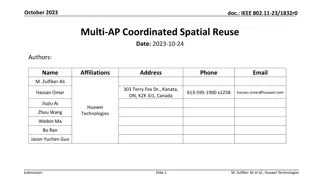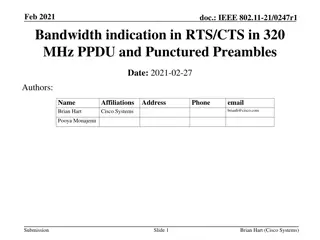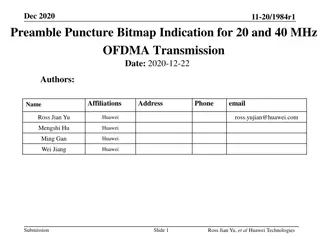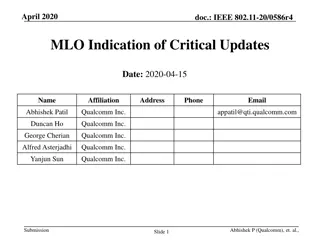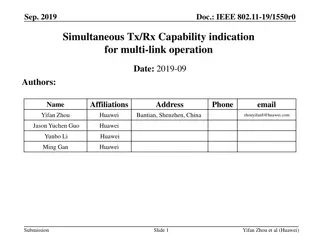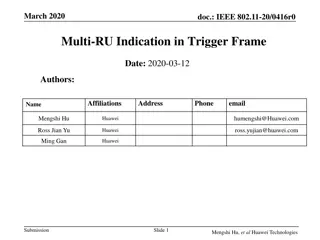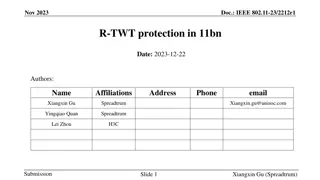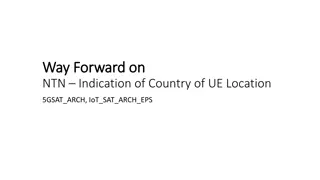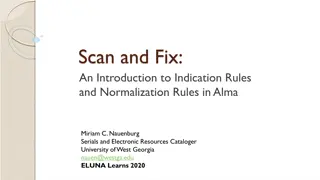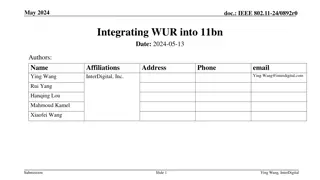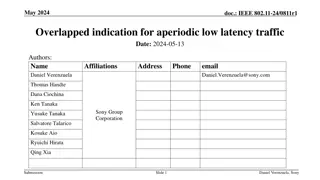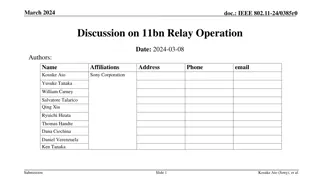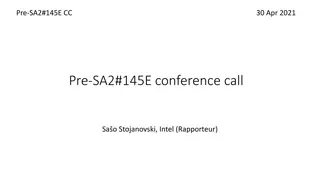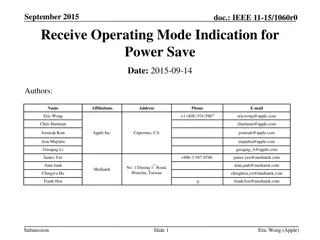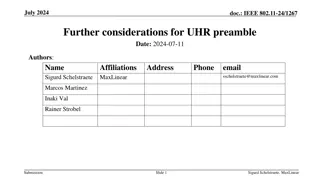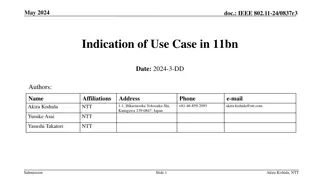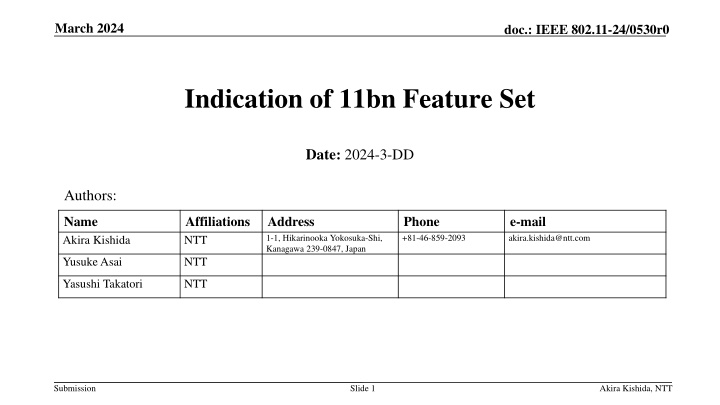
Indication of 11bn Features and Parameters in IEEE 802.11-24/0530r0 Document
Explore the importance of indicating a set of 11bn features and parameters in IEEE 802.11-24/0530r0 document for efficient utilization of technologies in various use cases. The document discusses coordination controls, supporting latency-sensitive traffic, and application of technologies based on specific requirements. Discover how capabilities and issues are indicated, enhancing the operation of 11bn technologies in different network architectures and use cases.
Download Presentation

Please find below an Image/Link to download the presentation.
The content on the website is provided AS IS for your information and personal use only. It may not be sold, licensed, or shared on other websites without obtaining consent from the author. If you encounter any issues during the download, it is possible that the publisher has removed the file from their server.
You are allowed to download the files provided on this website for personal or commercial use, subject to the condition that they are used lawfully. All files are the property of their respective owners.
The content on the website is provided AS IS for your information and personal use only. It may not be sold, licensed, or shared on other websites without obtaining consent from the author.
E N D
Presentation Transcript
March 2024 doc.: IEEE 802.11-24/0530r0 Indication of 11bn Feature Set Date: 2024-3-DD Authors: Name Akira Kishida Affiliations NTT Address 1-1, Hikarinooka Yokosuka-Shi, Kanagawa 239-0847, Japan Phone +81-46-859-2093 e-mail akira.kishida@ntt.com Yusuke Asai NTT Yasushi Takatori NTT Submission Slide 1 Akira Kishida, NTT
March 2024 doc.: IEEE 802.11-24/0530r0 Introduction In TGbn, various technologies, including coordination controls and supporting latency sensitive traffic technologies, are discussed to realize the scope of the project indicated in the PAR[1], and use cases in the CSD[2]. e.g., Multi-AP coordination (coordinated R-TWT and coordinated TDMA, etc) [3]-[12], preemption for sporadic latency sensitive traffic support[13][14]. The effectiveness of those technologies depends on the operating use case because the reliability requirement is different according to each use case[15][16]. Managed network architecture[17] will provide AP-centric scheduled operations suitable for private networks. Also, features supporting latency sensitive traffic will be essential, especially in specific use cases such as industrial automation[18]. Therefore, we discuss the features of indication of a set of 11bn features and parameters according to the use case. Submission Slide 2 Akira Kishida, NTT
March 2024 doc.: IEEE 802.11-24/0530r0 Application of 11bn technologies according to use cases and requirements What 11bn technologies should be applied depends on the requirements of each use case. 11bn technologies do not simply enhance throughput different from previous primal standards. It depends on the requirements of the use case whether supporting latency sensitive traffic (periodic or sporadic) or applying coordination controls is needed. For example, proactive coordination or latency improvement controls can be operated in private networks where the area owner exists (e.g., enterprise or industrial automation use cases) and refrain from using those controls in public networks. Knowing what features will be operated would help to control appropriate 11bn technologies. Submission Slide 3 Akira Kishida, NTT
March 2024 doc.: IEEE 802.11-24/0530r0 Indication of capabilities and issues Various information elements in management frames, such as Beacon, Probe Request, and Probe Response frames indicate the capabilities of supporting features. More features are defined in a new standard, and more information elements are created and included in management frames. This results in the bloating of management frames. Capabilities do not signify what features are operated in the BSS. For example, though supporting Multi-AP coordination is indicated, any coordination control might not actually be operated if there is no necessity for the coordination. If features and parameters to be operated are indicated as a feature set, efficient use of 11bn technologies could be achieved. For example, an AP can avoid the channel(s) or link(s) that other BSS operates latency sensitive traffic feature set. Submission Slide 4 Akira Kishida, NTT
March 2024 doc.: IEEE 802.11-24/0530r0 Indication of the operating 11bn features and parameters Rather than individually indicating the operating information for each feature, it is preferable to indicate an index defining a set of features to be operated. Indicating each operating feature in addition to capabilities individually will increase information and result in the bloating of management frames. Defining features included in a feature set for each index is a future discussion item in TGbn. The operating use case could be utilized as an index for the feature set. By indicating the operating use cases as an index, AP(s) and STA(s) can set features and parameters that should be operated. There is room for consideration of other methods to indicate the operating features in TGbn. Indication Configuration (TBD) Notification Step 3: Notify the information of the index (use case). - Associated STAs can decide the operating feature set based on the information. - Others can know what features will be operated. Step 1: Indicate the index (use case) that will be operated in the BSS. Step 2: Specify the operating feature set and its parameters designated by the index. e.g., C-RTWT, C-TDMA, Preemption, TXOP sharing e.g., No.x: Factory and Industrial Submission Slide 5 Akira Kishida, NTT
March 2024 doc.: IEEE 802.11-24/0530r0 Difference between capabilities and the operating features The capability means the ability that the STA to support the features. Announced by management frames and so on. The operating feature is the feature that the STA actually uses (or has a possibility to use) during its operation. Indicating a set of these operating features is the point of this contribution. Indication information might be some kind of IE (TBD) and it should contain minimum information such as Information index. Management frames Indication information (e.g., some kind of IE) Feature B is supported but not in use actually. IE a (Feature A) Feature A and operating parameters These operating features should not be notified individually to reduce information bloating. (These operating features correspond with the index) IE b (Feature B) Feature C and operating parameters IE c (Feature C) Feature F and operating parameters Feature H and operating parameters IE x (Feature X) Only features used in actual are listed. Capabilities Operating features Submission Slide 6 Akira Kishida, NTT
March 2024 doc.: IEEE 802.11-24/0530r0 Summary Unlike previous primary standards, IEEE 802.11bn aims to improve reliability, and the reliability requirement is different according to each use case. 11bn technologies should be operated appropriately according to the requirements of applications and use cases. Therefore, indicating an index that denotes a feature set of the operating features and parameters is considered. The use case is a candidate of the index for the indication. The operating features denote features that will be operated actually and differ from the capabilities of features that the APs or STAs have. Submission Slide 7 Akira Kishida, NTT
March 2024 doc.: IEEE 802.11-24/0530r0 SP Do you agree that indicating the operating features and parameters defined in 11bn is beneficial? -Yes -No -Abstain Submission Slide 8 Akira Kishida, NTT
March 2024 doc.: IEEE 802.11-24/0530r0 Reference [1] [2] [3] [4] [5] [6] [7] [8] [9] [10] Liuming Lu, et al., Multi-AP Coordination for Low Latency Traffic Delivery, IEEE 802.11-23/1556r1 [11] Abhishek Patil, et al., Coordinated TDMA (C-TDMA) Follow-up, IEEE 802.11-23/1895r2 [12] Geonhwan Kim, et al., Coordinated TDMA Procedure, IEEE 802.11-23/1912r0 [13] Giovanni Chisci, et al., Preemption techniques to meet low-latency (LL) targets, IEEE 802.11-23/1886r1 [14] Kiseon Ryu, et al., TXOP Preemption Follow Up, IEEE 802.11-23/1174r0 [15] Inaki Val, et al., High Criticality Use Cases and Requirements, IEEE 802.11-23/1834r0 [16] Brian Hart, et al., Overview of Enterprise Policy and Goals, IEEE 802.11-23/2026r0 [17] Inaki Val, et al., Managed Networks under highly congested scenarios, IEEE 802.11-23/1920r2 [18] Akira Kishida, et al., Considerations on UHR PAR and KPIs, IEEE 802.11-22/1919r4 Laurent Cariou, et al., UHR proposed PAR, IEEE 802.11-23/0480r3 Laurent Cariou, et al., IEEE 802.11 UHR Proposed CSD, IEEE 802.11-23/0079r10 Arik Klein, et al., M-AP Coordinated Transmission framework, IEEE 802.11-23/1871r2 Yanchun Li, et al., Discussion on UHR enhanced channel access, IEEE 802.11-23/1973r0 Laurent Cariou, et al., R-TWT for Multi-AP, IEEE 802.11-23/0297r0 SunHee Baek, et al., R-TWT Coordination in Multi-BSS, IEEE 802.11-23/1916r1 Liuming Lu, et al., Coordinated R-TWT for Multi-AP scenarios - Follow up, IEEE 802.11-23/1952r1 Jeongki Kim, et al., Discussion on Enhanced R-TWT for UHR, IEEE 802.11-23/2084r0 Xiangxin Gu, et al., R-TWT protection in 11bn, IEEE 802.11-23/2212r0 Submission Slide 9 Akira Kishida, NTT


